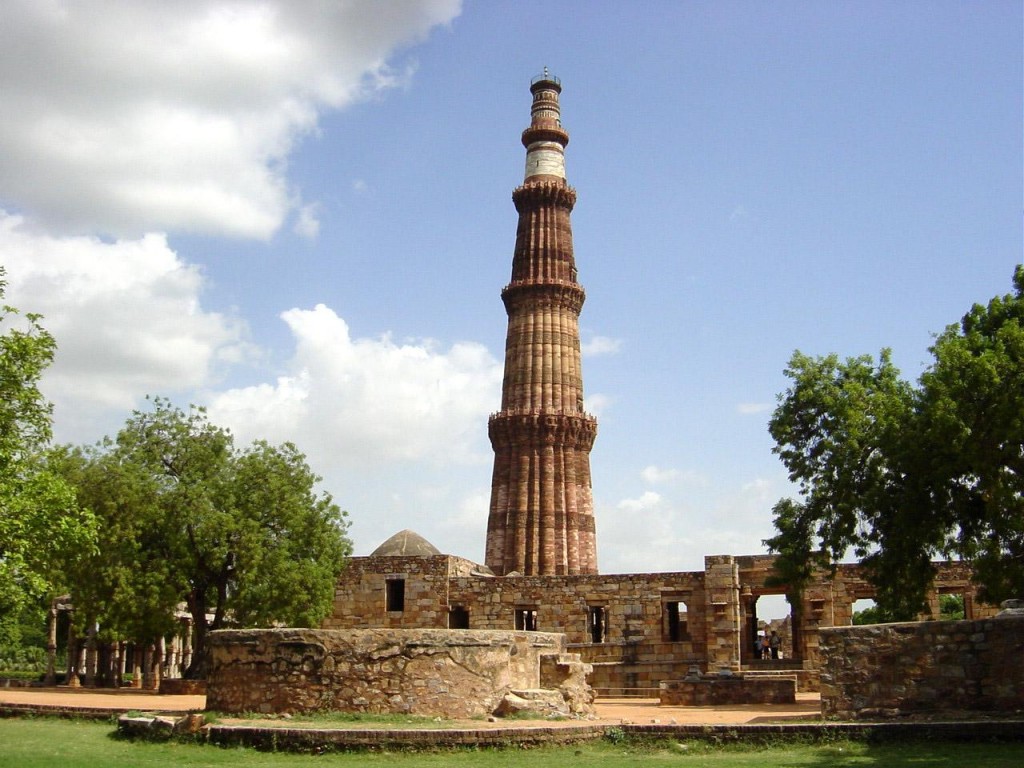The Timeless Tale of Qutub Minar.
In the heart of Delhi, amidst bustling streets and the hum of modern life, rises a silent sentinel from the 12th century—Qutub Minar, a towering minaret of red sandstone that has seen empires rise and fall, whispers echo through time, and perhaps… something more mysterious.
The Qutub Minar was built in the 12th century by Qutb-ud-din Aibak, the founder of the Mamluk dynasty, in 1192. He laid the foundation of Qutub Minar to mark the beginning of Muslim rule in India. The construction of Qutub Minar was completed later by his successors, notably Iltutmish and later Firoz Shah Tughlaq, after lightning damaged its top floors. Today, this UNESCO World Heritage Site stands tall at 73 meters, making it the tallest brick minaret in the world. 
Lesser-Known Facts You Never Knew
It Was Not Originally Islamic
Many historians believe that Qutub Minar was constructed on the remains of a Hindu or Jain temple complex, despite the widespread belief that it is a symbol of Islamic dominance. Nearby stands the Quwwat-ul-Islam Mosque—literally “Might of Islam”—built using stones from 27 demolished temples. Its pillars still carry Hindu motifs, lotus designs, bells, and inscriptions.
The Time-Defying Iron Pillar
Just a few feet from the Minar stands a 1,600-year-old Iron Pillar, established during the Gupta dynasty. This Iron Pillar has not rusted in over a millennium, baffling metallurgists. Dedicated to Lord Vishnu, it is believed to have been constructed in the 4th century CE. Legends say circling it with your arms backwards once granted wishes.
Surviving Lightning Strikes
In 1369, lightning destroyed the Minar’s top floor. It was Firoz Shah Tughlaq who finished the construction of Qutub Minar by rebuilding the damaged sections, this time using marble instead of sandstone. That is why the upper floors look different from the lower red sandstone ones.
Power and Conquest
Verses from the Quran are engraved on the walls of the Minar. Beneath these, however, traces of Sanskrit and Brahmi inscriptions still exist—suggesting the site had Hindu religious significance long before Qutb-ud-din Aibak conquered it.
The Whispers in Qutub Minar
Though a popular tourist spot, the Minar has eerie tales attached. Guards and visitors have reported ghostly whispers near the Iron Pillar and around the steps of the tower after sunset.
In 1981, during a school trip, a tragic stampede inside the minaret killed 45 children. Since then, the Qutub Minar was permanently closed for climbing. Today, tourists can only admire its beauty from the ground.
Local folklore even claims that spirits of monks and rulers guard the Minar. Some people who tried recording videos here at night reported strange malfunctions.
The Battle of Faiths and Architecture
The Qutub Minar was built by the Mamluk dynasty, but its foundations whisper of older faiths. The mosque beside it, Quwwat-ul-Islam, was built directly on demolished temple ruins. Carvings of Nataraja (Dancing Shiva), Lotus motifs, Swastika, and Kalash are still visible—though many were defaced.
Some historians believe Qutub Minar may originally have been a Vishnu Stambha (Tower of Vishnu), possibly an astronomical tower later repurposed. While mainstream archaeology doesn’t endorse this claim, the reused temple materials strongly suggest a Hindu past.
The Structure of Qutub Minar
-
Floors: Qutub Minar has five floors, each marked by a projecting balcony.
-
Material used in Qutub Minar: Primarily red sandstone, with marble added by later rulers like Firoz Shah Tughlaq.
-
Height: 73 meters tall, making it the tallest brick minaret in the world.
-
Qutub garden: Surrounding the minaret is the lush Qutub garden, perfect for peaceful walks and photography.
Last Thoughts
The Qutub Minar established in Delhi is more than just a monument—it is a living chronicle of conquests, culture, and perhaps the supernatural. Whether you see it as a symbol of Islamic architecture or as a remnant of displaced Hindu temples, the Minar embodies Delhi’s layered history.
If you plan to visit, go early morning or late afternoon for the best light and fewer crowds. Stay back only till sunset—the gates close for a reason.
Disclaimer
Qutub Minar is one of India’s most iconic landmarks and a UNESCO World Heritage Site. Myths, legends, and ghost stories enrich its aura, but they should be seen as folklore. This blog aims to spark curiosity about the historical and cultural significance of Qutub Minar, not fear.



